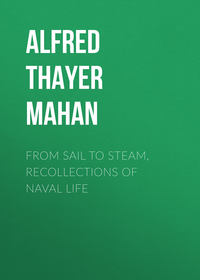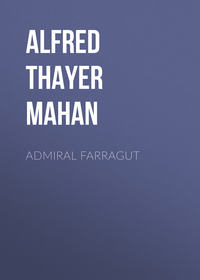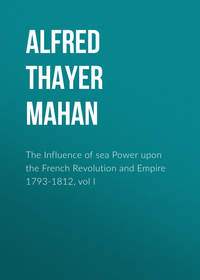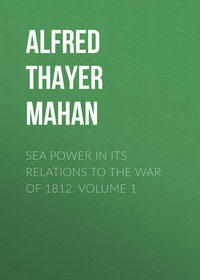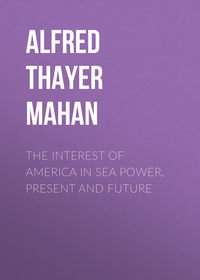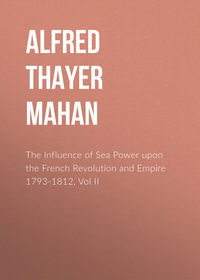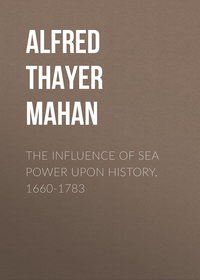 полная версия
полная версияThe Major Operations of the Navies in the War of American Independence
The bowsprit formerly had one yard, called the spritsail yard. This has disappeared. Otherwise it serves to spread the three-cornered sails called jibs. These sails were useful for turning a vessel, because their projection before the centre gave them great leverage.
Fore and aft vessels had no yards. See "Sails."
Spring. See p. 65, note.
Square-rigged. See "Sails" and "Spars."
Stand, to. Used, nautically, to express movement and direction, e.g., "to stand toward the enemy," "to stand out of harbor," "to stand down," "to stand south." The underlying idea seems to be that of sustained, decided movement.
Starboard. TO the right hand, or on the right side, of a vessel, looking from aft forward. Opposite to Port.
Steer, to. To control the course by the use of the helm and rudder.
Stern. The extreme rear, or after, part of a vessel.
Strategy. That department of the Art of War which decides the distribution and movements of armies, or of fleets, with reference to the objects of a campaign as a whole.
Strike, to. Applied to the flag. To haul down the flag in token of surrender.
Tack. A vessel is on the starboard tack, or port tack, according as the wind comes from the starboard or port hand. See p. 84, note.
Tack, to. When a vessel is close-hauled, with the wind on one side, to tack is to turn round towards the wind, in order to be again close-hauled, with the wind on the other side.
To wear is to attain the same object by turning away from the wind. Wearing is surer than tacking, but loses ground to leeward.
To tack, or wear, in succession, the leading vessel tacks, and those which follow tack, each, as it arrives at the same point; the order thus remaining the same. To tack, or wear together, all tack at the same moment, which reverses the order.
Tactics. That department of the Art of War which decides the disposition and movements of an army, or of a fleet, on a particular field of battle, in presence of an enemy.
Tidal Currents.
Ebb tide, the outflow of the water due to the tides.
Flood tide, the inflow of the water due to the tides.
Lee tide, the set of the current to leeward.
Weather tide, the set of the current to windward.
Tide. The rise and fall of the water of the oceans under the influence of the moon. Used customarily, but inaccurately, to express the currents produced by the changes of level.
High tide, or high water, the two highest levels of the day.
Low tide, or low water, the two lowest.
Neap tide: the least rise and fall during the lunar month.
Spring tide: the greatest rise and fall during the same, being soon after full and change of moon.
Trade, the. A term applied to a body of merchant vessels, to or from a particular destination.
Trade Wind. A wind which blows uniformly from the same general direction throughout a fixed period. In the West Indies, from the northeast the year round. See also "Monsoon."
Veer. See "Cable."
Vessel. A general term for all constructions intended to float upon and move through the water. Specific definitions applicable to this book:
Ship, a square-rigged vessel with three masts.
Brig, a square-rigged vessel with two masts.
Schooner, a fore and aft rigged vessel with two or more masts.
Sloop, a fore and aft rigged vessel with one mast. See pp. 9, 15, 17.
Vessels of War. Ship of the Line. A ship with three or more tiers of guns, of which two are on covered decks; that is, have a deck above them. See "Line of Battle Ship."
Frigate. A ship with one tier of guns on a covered deck.
Sloop of War. A ship, the guns of which are not covered, being on the upper (spar) deck.
Sloops of war were sometimes brigs, but then were usually so styled.
Wake. The track left by a vessel's passage through the water. "In the wake of": directly astern of.
Way. Movement through the water. "To get underway": to pass from stand-still to movement.
Wear, to. See under "Tack."
Weather. Relative position to windward of another object. Opposite to Lee. Weather side, lee side, of a vessel; weather fleet, lee fleet; weather gage, lee gage (see "Gage"); weather shore, lee shore.
Weather, to. To pass to windward of a vessel, or of any other object.
Weatherly. The quality of a vessel which favors her getting, or keeping, to windward.
Weigh, to. To raise the anchor from the bottom. Used alone; e.g., "the fleet weighed."
Wheel. So called from its form. The mechanical appliance, a wheel, with several handles for turning it, by which power is increased, and also transmitted from the steersman on deck to the tiller below, in order to steer the vessel.
Wind and Water, between. That part of a vessel's side which comes out of water when she inclines to a strong side wind, but otherwise is under water.
Windward. Direction from which the wind blows.
Yard. See "Spars."

North Atlantic Ocean. General Map to illustrate Operations in the War of American Independence
1
In customary representation of maps, North is upper, and movement northward is commonly spoken of as up. It is necessary therefore to bear in mind that the flow of water from Lake George to the St. Lawrence, though northward, is down.
2
Afterwards Captain of the Fleet (Chief of Staff) to Rodney in his great campaign of 1782. Post, p. 222. He died a Rear-Admiral and Baronet in 1789.
3
Author's italics.
4
Remembrancer, iv. 291.
5
The radeau had six 24-pounders, six 12's, and two howitzers; the gondola, seven 9-pounders. The particulars of armament are from Douglas's letters.
6
By American reports. Beatson gives the force sent out, in the spring of 1776, as 13,357. ("Mil. and Nav. Memoirs," vi. 44.)
7
Douglas's letters.
8
Douglas thought that the appearance of the Inflexible was a complete surprise; but Arnold had been informed that a third vessel, larger than the schooners, was being set up. With a man of his character, it is impossible to be sure, from his letters to his superior, how much he knew, or what he withheld.
9
called North Hero.
10
Douglas's letter. The Isis and the Blonde were vessels of the British squadron under Douglas, then lying in the St. Lawrence. The officers named were temporarily on the lake service.
11
Sandwich, First Lord of the Admiralty, to Pellew.
12
Beatson, "Nav. and Mil. Memoirs," says two hours.
13
Douglas's letters. The sentence is awkward, but carefully compared with the copy in the author's hands. Douglas says, of the details he gives, that "they have been collected with the most scrupulous circumspection."
14
Post, p. 205.
15
At the present day reduced by reclaimed land.
16
Beatson's "Military and Naval Memoirs," vi. 44, give 34,614 as the strength of Howe's army. Clinton's division is not included in this. vi. 45.
17
Admiral James's Journal, p. 30. (Navy Records Society.)
18
This was just below the mouth of the Schuylkill, a short distance below the present League Island navy yard.
19
Charles H., Comte d'Estaing. Born, 1729. Served in India under Lally Tollendal, 1758. After having been taken prisoner at Madras in 1759, exchanged into the navy. Commanded in North America, 1778-80. Guillotined, 1794. W.L.C.
20
Grandfather of the poet.
21
The Secretary of Lloyd's, for the purposes of this work, has been so good as to cause to be specially compiled a summary of the losses and captures during the period 1775-1783. This, so far as it deals with merchantmen and privateers, gives the following results.
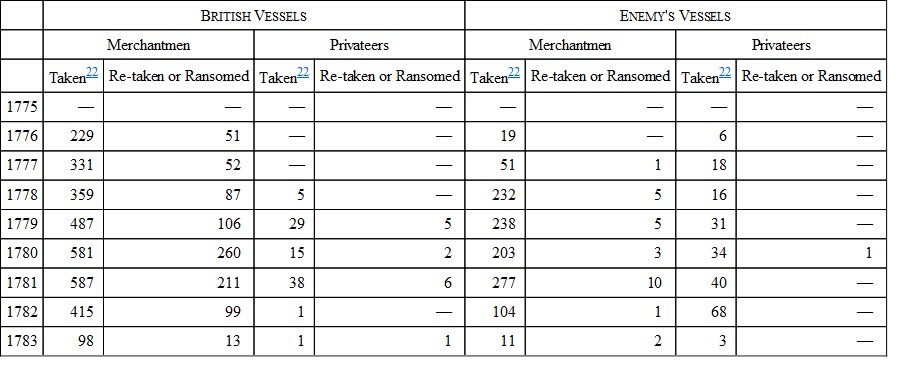
22 Including those re-taken or ransomed. W.L.C.
22
A spring is a rope taken usually from the quarter (one side of the stern) of a ship, to the anchor. By hauling upon it the battery is turned in the direction desired.
23
The leader, the Leviathan, was excepted, evidently because she lay under the Hook, and her guns could not bear down channel. She was not a fighting ship of the squadron, but an armed storeship, although originally a ship of war, and therefore by her thickness of side better fitted for defence than an ordinary merchant vessel. Placing her seems to have been an afterthought, to close the gap in the line, and prevent even the possibility of the enemy's ships turning in there and doubling on the van. Thus Howe avoided the fatal oversight made by Brueys twenty years later, in Aboukir Bay.
24
It may be recalled that a similar disposition was made by the Confederates at Mobile against Farragut's attack in 1864, and that it was from these small vessels that his flagship Hartford underwent her severest loss. To sailing ships the odds were greater, as injury to spars might involve stoppage. Moreover, Howe's arrangements brought into such fire all his heavier ships.
25
A letter to the Admiralty, dated October 8th, 1779, from Vice-Admiral Marriot Arbuthnot, then commander-in-chief at New York, states that "at spring tides there is generally thirty feet of water on the bar at high water."
26
These four ships were among the smallest of the fleet, being one 74, two 64's, and a 50. D'Estaing very properly reserved his heaviest ships to force the main channel.
27
Flora, 32; Juno, 32; Lark, 32; Orpheus, 32; Falcon, 16.
28
I have not been able to find an exact statement of the number; Beatson gives eight regiments, with a reinforcement of five battalions.
29
It may be interesting to recall that this was the ship on the books of which Nelson's name was first borne in the navy, in 1771.
30
Troude attributes d'Estaing's sortie to a sense of the insecurity of his position; Lapeyrouse Bonfils, to a desire for contest. Chevalier dwells upon the exposure of the situation.
31
For the respective force of the two fleets see pp. 66, 67, 71.
32
This account of the manœuvres of the two fleets is based upon Lord Howe's dispatch, and amplified from the journal of Captain Henry Duncan of the flagship Eagle which has been published (1902) since the first publication of this work. See "Navy Records Society, Naval Miscellany." Vol. i, p. 161.
33
At the mouth of Delaware Bay.
34
Ante, p. 62.
35
Chevalier: "Marine Française," 1778.
36
Later Vice-Admiral Sir Hyde Parker, Bart., who perished in the Cato in 1783. He was father of that Admiral Sir Hyde Parker, who in 1801 was Nelson's commander-in-chief at Copenhagen, and who in 1778 commanded the Phœnix, 44, in Howe's fleet. (Ante, pp. 39, 46.)
37
Ante, pp. 61, 62.
38
Testimony of Captains Hood, Robinson, and Macbride, and of Rear-Admiral Campbell, captain of the fleet to Keppel.
39
See note on preceding page.
40
A vessel is said to be on the port tack when she has the wind blowing on her port, or left side; on the starboard tack, when the wind is on the right side. Thus with an east wind, if she head north, she is on the starboard tack; if south, on the port.
41
See also note; post, p. 200.
42
Twenty-two degrees.
43
Column and line ahead are equivalent terms, each ship steering in the wake of its next ahead.
44
Forty-five degrees.
45
Chevalier says, p. 89, "The English passed out of range" of these ships. As these ships had the wind, they had the choice of range, barring signals from their own admiral. In truth, they were obeying his order.
46
This evidence of the captains of the Ocean and the Elizabeth contradicts Palliser's charge that his ship was not adequately supported.
47
It was actually quite equal, but this was due to an accidental explosion on board the Formidable.
48
Chevalier. Probably later by the other times used in this account.
49
The Order of Battle was constituted by the ships "of the line" ranging themselves one behind the other in a prescribed succession; the position of each and the intervals between being taken from the ship next ahead. This made the leading vessel the pivot of the order and of manœuvring, unless specially otherwise directed; which in an emergency could not always be easily done. Strictly, if circumstances favoured, the line on which the ships thus formed was one of the two close-hauled lines; "close-hauled" meaning to bring the vessel's head as "near" the direction of the wind as possible, usually to about 70 degrees. The advantage of the close-hauled line was that the vessels were more manageable than when "off" the wind.
50
Evidence of Captain John Laforey, of the Ocean.
51
"I do not recollect how many points I went from the wind; I must have bore down a pretty large course." Testimony of Captain J. Laforey, of the Ocean, on this point.
52
"During the night (of the 27th) Admiral Keppel kept away (fit route) for Portsmouth." Chevalier, "Marine Française," p. 90. Paris, 1877. Oddly enough, he adds that "on the evening of the 28th the French squadron, carried eastward by the currents, sighted Ushant."
53
The French accounts say three.
54
Beatson, "Military and Naval Memoirs," iv. 390.
55
Santa Lucia being in the region of the north-east trade winds, north and east are always windwardly relatively to south and west.
56
To the westward. These islands lie in the trade-winds, which are constant in general direction from north-east.
57
Admiral Keppel, in his evidence before the Palliser Court, gave an interesting description of a similar scene, although the present writer is persuaded that he was narrating things as they seemed, rather than as they were—as at Grenada. "The French were forming their line exactly in the manner M. Conflans did when attacked by Admiral Hawke." (Keppel had been in that action.) "It is a manner peculiar to themselves; and to those who do not understand it, it appears like confusion. They draw out ship by ship from a cluster."
58
That is, towards the ships at anchor,—the enemy's rear as matters then were.
59
Byron's Report. The italics are the author's.
60
Byron's Report.
61
Ibid. Author's italics.
62
"Naval Researches." London, 1830, p. 22.
63
Byron's Report.
64
Pierre A. de Suffren de Saint Tropez, a Bailli of the Order of Knights of Malta. Born, 1726. Present at two naval actions before he was twenty. Participated in 1756 in the attack on Port Mahon, and in 1759 in the action off Lagos. Chef d'escadre in 1779. Dispatched to the East Indies in 1781. Fought a British squadron in the Bay of Praya, and a succession of brilliant actions with Sir Edward Hughes, 1782-83. Vice-Admiral, 1783. Killed in a duel, 1788. One of the greatest of French naval officers.—W.L.C.
65
Troude says that one French seventy-four, having touched in leaving port, was not in the engagement.
66
First of the name. Born 1714. In 1780, he fell under Rodney's censure, and went home. In 1781, he commanded in the general action with the Dutch, known as the Dogger Bank. In 1782, he sailed for the East Indies in the Cato, 64; which ship was never again heard from.
67
Sir Hyde Parker, Kt. Second of the name, son of the first. Born, 1739. Captain, 1763. Rear-Admiral, 1793. Vice-Admiral, 1794. Admiral, 1799. Died, 1807. Nelson's chief at Copenhagen, in 1801.
68
Louis Urbain de Bouënic, Comte de Guichen. Born, 1712. Entered the navy, 1730. Commanded the Illustre with success in North America in 1756. Second in command in the action off Ushant in 1778. Thrice fought Rodney in the West Indies in 1780. Fought Kempenfelt off the Azores in 1781. Died, 1790.—W.L.C.
69
An anchorage three miles to seaward of Spithead.
70
Chevalier, "Marine Française," 1778, p. 165. Author's italics.
71
In line "abreast," as the word indicates, the ships are not in each other's wake, as in line "ahead," but abreast; that is, ranged on a line perpendicular to the course steered.
72
Rodney's Report. Chevalier says that one of them was retaken by her crew and carried into Cadiz.
73
Now the British Mauritius.
74
Parker's Report.
75
Ibid.
76
Ante, p. 115.
77
Rodney's Report. The French authorities give their line of battle as twenty-two ships of the line. There was no 90-gun ship among them—no three-decker; but there were two of 80 guns, of which also the British had none.
78
A cable was then assumed to have a length of 120 fathoms,—720 feet.
79
A properly formed line of twenty ships, at two cables' interval, would be about five miles long. Rodney seems to have been satisfied that this was about the condition of his fleet at this moment.
80
Rodney's Report.
81
Testimony of the signal officer at the court-martial on Captain Bateman.
82
Singularly enough, this officer was afterwards court-martialled for misbehaviour, on the 1st of June, 1794, of precisely the same character as that from all share in which Rodney now cleared him.
83
The words in Rodney's public letter, suppressed at the time by the Admiralty, agree with these, but are even more explicit. "I cannot conclude this letter without acquainting their Lordships that had Captain Carkett, who led the van, properly obeyed my signal for attacking the enemy, and agreeable to the 21st Article of the Additional Fighting Instructions, bore down instantly to the ship at that time abreast of him, instead of leading as he did to the van ship, the action had commenced much sooner, and the fleet engaged in a more compact manner...." This clearly implies that the Additional Fighting Instructions prescribed the direction which Rodney expected Carkett to take. If these Additional Instructions are to be found, their testimony would be interesting.
Since this account was written, the Navy Records Society has published (1905) a volume, "Fighting Instructions, 1530-1816," by Mr. Julian Corbett, whose diligent researches in matters of naval history and warfare are appreciated by those interested in such subjects. The specific "Additional Instructions" quoted by Rodney appear not to have been found. Among those given prior to 1780 there is none that extends to twenty-one articles. In a set issued by Rodney in 1782 an article (No. 17, p. 227) is apparently designed to prevent the recurrence of Carkett's mistake. This, like one by Hawke, in 1756 (p. 217), prescribes the intended action rather by directing that the line of battle shall not prevent each ship engaging its opponent, irrespective of the conduct of other ships, than by making clear which that opponent was. Lucidity on this point cannot be claimed for either.
84
Lapeyrouse Bonfils, "Histoire de la Marine Française," iii, 132. Chevalier gives much smaller numbers, but the former has particularised the ships.
85
Chevalier, "Marine Française," 1778, p. 185.
86
A lee current is one that sets to leeward, with the wind, in this case the trade-wind.
87
Chevalier, p. 91.
88
Ante, p. 115.
89
Beatson, "Military and Naval Memoirs."
90
This latter is applied to vessels, usually ships of war, which are used as transports or supply ships, and therefore carry only a part of their normal battery.
91
Rodney said that Hood "lay-to" for the night. This is antecedently incredible of an officer of Hood's character, and is expressly contradicted by Captain Sutherland of the Russell. "At 6 P.M. (of the 28th) our fleet tacked to the north, and kept moving across the bay (Fort Royal) for the right (sic), in line of battle." Ekins, "Naval Battles," p. 136. The word "right" is evidently a misprint for "night." Rodney's criticisms seem to the author captious throughout.
92
One French ship had left the fleet, disabled.
93
Ante, p. 153.
94
See ante, p. 153.
95
Along the north coast of Cuba, between it and the Bahama Banks.
96
The Ville de Paris, to which Troude attributes 104 guns. She was considered the biggest and finest ship of her day.
97
This reproduced the blunder of Byng, between whose action and the one now under discussion there is a marked resemblance.
98
I.e. she had stopped.
99
Hood himself.
100
Letters of Lord Hood, p. 32. Navy Records Society. My italics. Concerning the crucial fact of the signal for the line of battle being kept flying continuously until 5.30 P.M., upon which there is a direct contradiction between Hood and the log of the London, it is necessary to give the statement of Captain Thomas White, who was present in the action in one of the rear ships. "If the London's log, or the log of any other individual ship in the fleet, confirm this statement," (that Hood was dilatory in obeying the order for close action), "I shall be induced to fancy that what I that day saw and heard was a mere chimera of the brain, and that what I believed to be the signal for the line was not a union jack, but an ignis fatuus conjured up to mock me." White and Hood also agree that the signal for the line was rehoisted at 6.30. (White: "Naval Researches," London, 1830, p. 45.)




